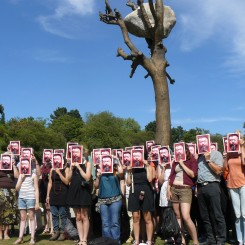There are, though, significant dangers in the upholding of Ai as our sole representative/mediator of artistic resistance to authority within China. While Ai’s bluntly confrontational and often bombastic stance can be readily digested within Western liberal-democratic contexts where romantic notions of heroic dissent in the face of overwhelming power still persist, it is by no means representative of the critical positioning of most other Chinese artists. Ai may have situated himself admirably behind enlightened westernized ideals of freedom and openness, but the sheer bluntness and reductive simplicity of his critical approach to authority have effectively foreclosed a more searching discussion of contemporary art within China as well as the complex, web of localized cultural, social, political and economic forces that surround its production and reception.
Within China there are, of course, a great number of contemporary artists who have brought together Chinese and non-Chinese cultural influences simply in pursuit of commercial success. There are also a very few who, like Ai, have adopted an openly hostile approach towards authority. But there are also many others who have sought to develop sophisticated hybrid visual languages capable of sustaining rather more subtle forms of critical reflection and expression. As part of China’s Daoist-Confucian tradition, there is a long-established understanding that art has the potential go beyond the merely formalistic to offer meaningful social commentary and spiritual enlightenment. In accordance with that tradition, artistic criticism of authority within China has tended towards the poetic and allegorical as well as the exercising of symbolic forms of withdrawal. This lack of open criticism of authority is not entirely a matter of pragmatism. It is also considered a marker of civilization. For the civilized Chinese artist who wishes to rise above the vulgarities of power, poetic and allegorical forms of criticism not only resist easy definition, they are also assumed to have the force of an unstoppable spontaneity commensurate with the way of nature; one metaphorized in the Daoist classic the Daodejing by observations of the destructive action of water on stone.
“Art of Change” is an important and ground-breaking showcase for the complex range of critical responses to power and social change within the PRC. While some of the works included in the exhibition encompasses aspects of traditional Chinese cultural thought and practice as a resistant departure from mainstream Chinese life and politics, others present recognizably (and understandably) encoded responses to the tragic absurdities of a society still subject to crushing bureaucracy, corruption and lack of accountability. Examples of the former include Liang Shaoji’s use of ready-mades as sculptural supports for the depositing of silk by live silk worms, which resonates strongly with, amongst other things, the artist’s interest in Daoist and Einsteinian relativity — a distinct foil to current Chinese Communist Party supported-notions of rational-scientific progress. Among the latter are videos and installation works by Sun Yuan and Peng Yu, Gu Dexin and Wang Jianwei that present often complex and highly oblique allegories of the combined effects and inherent contradictions of China’s entry into global modernity and the localized persistence of totalitarian power.
From a Westernised post-Enlightenment perspective all of this presents itself as unutterably weak, complicit and, perhaps, self orientalizing. However, China is not the West. There is little prospect of a shift any time soon towards the kinds of publicness and criticality now established in Western liberal democratic contexts. Nevertheless, for those with the patience to see there are localized forms of resistance that, while easily overlooked from a Western point of view, continue to act obliquely and perhaps tellingly over time on authority within China.
Ai Weiwei is right in drawing our repeated attention to the debilitating injustices of totalitarian power within China. He is also right to upbraid western viewers for their inability to see past what are for them the pleasurable ambiguities of contemporary Chinese art. Less convincing, however, is Ai’s wholly reductive view of the critical possibilities of contemporary art in China. By insisting on his own stridently oppositional approach towards power as the only legitimate game in town, and because we are already highly familiar with that approach, it is he and not the Hayward who has misrepresented the contemporary Chinese artworld. One might add that Ai is also romanticizing the conditions of criticality in the West.



